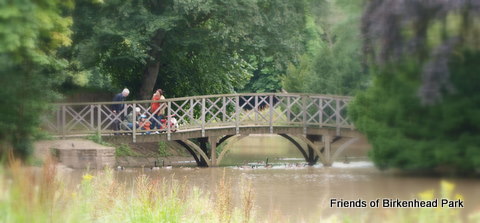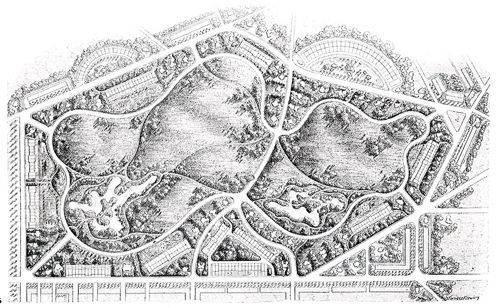A new view around every corner
Come and explore the beauty of the World's first publicly funded park
The Park
Birkenhead Park is acknowledged to be the first publicly funded park in Britain. It was the forerunner of the Park's Movement and its influence was far reaching both in this country and abroad - most notably on Olmsted's design for Central Park, New York. Designed by Joseph Paxton (later Sir Joseph Paxton) in 1843 and officially opened in 1847 it was an immediate economic and social success.
The early years of Birkenhead Park
Its history is inseparable from that of Birkenhead town itself. Distanced from the ravages of the Industrial Revolution in Liverpool and the North-West by the physical barrier of the River Mersey, Birkenhead retained its agricultural status until the advent of the steam ferry service in 1820. Ready access from Liverpool now opened up the Wirral for development and prompted the rapid growth of Birkenhead as an industrial centre. Within ten years the town's population had grown from just over one hundred to two and a half thousand. Recognising the need to exercise control over its development and establish municipal powers, the Government approved the setting up of the Birkenhead Improvement Commission in 1833 after an Act of Parliament.
At the same time, in the country as a whole, there was a growing awareness of the detrimental effects of overpopulation and the atrocious living and working conditions to be found in the major industrial areas. This promoted the establishment of various reform movements, including that of the 'Park's Movement'. Its central theory was that by providing open spaces for public use, the well-being of the industrial workforce was improved. In 1841, alarmed by the exploding population figures, the idea of a public park in Birkenhead was first raised by Mr Isaac Holmes, a Liverpool Councillor. Two years later, empowered by another Improvement Act, the Birkenhead Commissioners created history by purchasing land on which to construct the world's first publicly funded park. The site chosen for the park was part of the Birkenhead Estate, owned by Mr F R Price. The land was low lying, a mixture of fields, marsh and commons, and contained a small farmhouse which was a known beer den where illegal gambling and dog fighting took place.
The land was purchased cheaply because of its poor quality. 125 acres were designated for public use, the remaining 60 acres were to be sold for private residential development. The proceeds from the sale of the building plots was sufficient to recoup all the costs incurred by the purchase of the land and the construction of the park. An Improvement Committee chaired by William Jackson was set up to supervise the development of the park.
Joseph Paxton, a Landscape Gardener whose work in Liverpool had brought him to the attention of the Committee, was approached and in August 1843 he was engaged to design and construct the park at a fee of £800. By November 1843 the completed plan of the park and the preliminary sketches for the lodges (drawn up by Paxton's assistant, John Robertson) had been approved. Preparatory work began on the site under the supervision of Edward Kemp - later the Park Superintendent. A young Liverpool architect, Lewis Hornblower, was engaged to supervise the construction of the lodges, and to design and oversee other artefacts and building work within the park. Major planting of trees and shrubs was carried out during the planting season of Autumn 1844/Spring 1845. Attention was then directed to the establishment of grassland areas. Sixty acres of peripheral land were divided into building plots and sold for private development at two auctions and through estate agents. In order to ensure a degree of uniformity and consistent high standard of development, strict rules were laid down regarding the construction of the dwellings. Any unsold plots of land were eventually absorbed into the public area of the park. For example, the area now known as the Bowling Greens on Park Road North was laid out for bowls and quoits in 1880. The Boothby Ground was purchased from the Boothby Estate as late as 1903.
Work was virtually complete by Autumn 1846 but the official opening of the park was delayed until 5th April 1847, in order to coincide with the opening of the Birkenhead Dock Complex. The park was opened by Lord Morpeth and visited on that day by an estimated 10,000 people. The strength and flexibility of the original design were revealed over the years by the ease with which the park evolved to satisfy the changing demands of its users. From an almost entirely passive function the park absorbed facilities for active sports and large scale events. Commemorative trees were planted, unemployment relief schemes undertaken. Two World Wars intruded onto the park, different buildings and structures erected and then removed or demolished. Some areas such as the area known today as The Sunken Garden changed their nature and their name.


